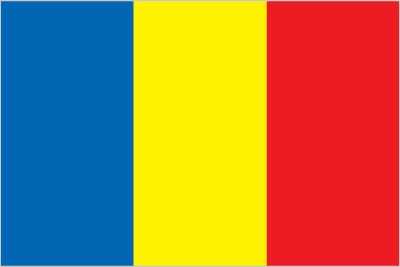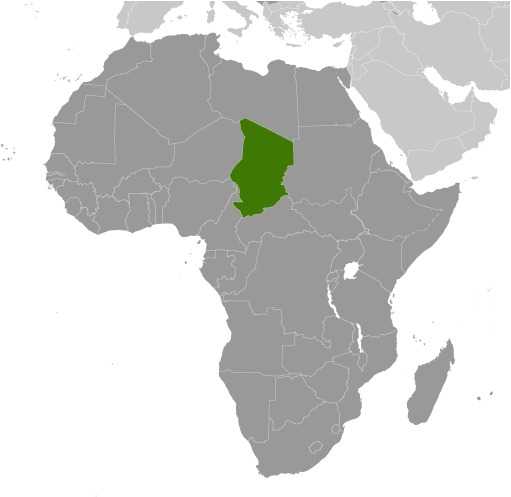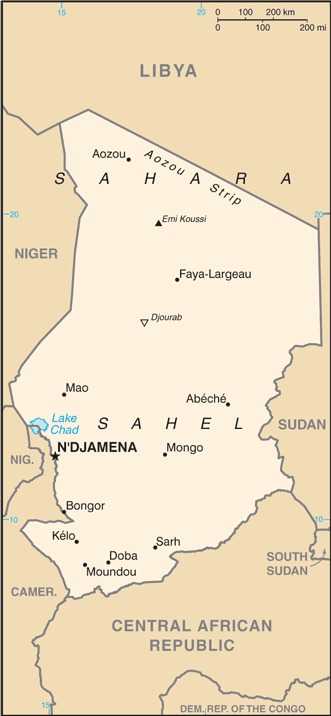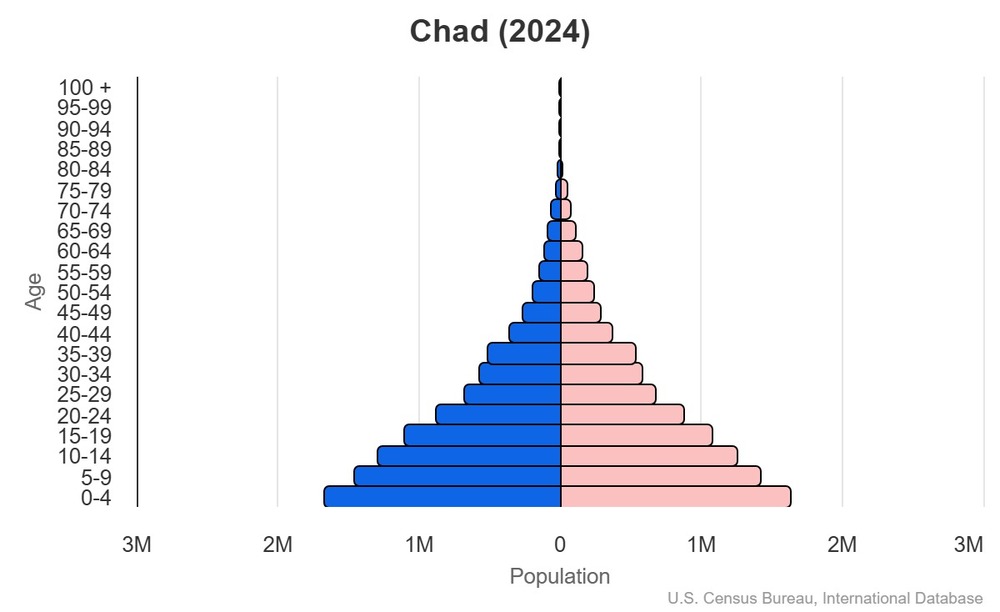Chad - TD - TCD - CHA - Africa



Chad Images
Chad Factbook Data
Diplomatic representation from the US
embassy: Rond-Point Chagoua, B.P. 413, N’Djamena
mailing address: 2410 N'Djamena Place, Washington DC 20521-2410
telephone: [235] 6885-1065
FAX: [235] 2253-9102
email address and website:
NdjamenaACS@state.gov
https://td.usembassy.gov/
Age structure
15-64 years: 51.7% (male 4,831,744/female 5,031,383)
65 years and over: 2.5% (2024 est.) (male 204,823/female 274,115)

For additional information, please see the entry for Population pyramid on the Definitions and Notes page.
Geographic coordinates
Sex ratio
0-14 years: 1.02 male(s)/female
15-64 years: 0.96 male(s)/female
65 years and over: 0.75 male(s)/female
total population: 0.98 male(s)/female (2024 est.)
Natural hazards
Area - comparative

almost nine times the size of New York state; slightly more than three times the size of California
Military service age and obligation
Background
Chad emerged from a collection of powerful states that controlled the Sahelian belt starting around the 9th century. These states focused on controlling trans-Saharan trade routes and profited mostly from the slave trade. The Kanem-Bornu Empire, centered around the Lake Chad Basin, existed between the 9th and 19th centuries, and at its peak, the empire controlled territory stretching from southern Chad to southern Libya and included portions of modern-day Algeria, Cameroon, Niger, Nigeria, and Sudan. The Sudanese warlord Rabih AZ-ZUBAYR used an army comprised largely of slaves to conquer the Kanem-Bornu Empire in the late 19th century. In southeastern Chad, the Bagirmi and Ouaddai (Wadai) kingdoms emerged in the 15th and 16th centuries and lasted until the arrival of the French in the 19th and 20th centuries. France began moving into the region in the late 1880s and defeated the Bagirmi kingdom in 1897, Rabih AZ-ZUBAYR in 1900, and the Ouddai kingdom in 1909. In the arid regions of northern Chad and southern Libya, an Islamic order called the Sanusiyya (Sanusi) relied heavily on the trans-Saharan slave trade and had upwards of 3 million followers by the 1880s. The French defeated the Sanusiyya in 1910 after years of intermittent war. By 1910, France had incorporated the northern arid region, the Lake Chad Basin, and southeastern Chad into French Equatorial Africa.
Chad achieved its independence in 1960 and then saw three decades of instability, oppressive rule, civil war, and a Libyan invasion. With the help of the French military and several African countries, Chadian leaders expelled Libyan forces during the 1987 "Toyota War," so named for the use of Toyota pickup trucks as fighting vehicles. In 1990, Chadian general Idriss DEBY led a rebellion against President Hissene HABRE. Under DEBY, Chad approved a constitution and held elections in 1996. Shortly after DEBY was killed during a rebel incursion in 2021, a group of military officials -- led by DEBY’s son, Mahamat Idriss DEBY -- took control of the government. The military officials dismissed the National Assembly, suspended the Constitution, and formed a Transitional Military Council (TMC), while pledging to hold democratic elections by October 2022. A national dialogue in August-October 2022 culminated in decisions to extend the transition for up to two years, dissolve the TMC, and appoint Mahamat DEBY as Transitional President; the transitional authorities held a constitutional referendum in December 2023 and claimed 86 percent of votes were in favor of the new constitution. The transitional authorities have announced plans to hold elections by October 2024.
Chad has faced widespread poverty, an economy severely weakened by volatile international oil prices, terrorist-led insurgencies in the Lake Chad Basin, and several waves of rebellions in northern and eastern Chad. In 2015, the government imposed a state of emergency in the Lake Chad Basin following multiple attacks by the terrorist group Boko Haram, now known as ISIS-West Africa. The same year, Boko Haram conducted bombings in N'Djamena. In 2019, the Chadian government also declared a state of emergency in the Sila and Ouaddai regions bordering Sudan and in the Tibesti region bordering Niger, where rival ethnic groups are still fighting. The army has suffered heavy losses to Islamic terror groups in the Lake Chad Basin.
Environmental issues
International environmental agreements
signed, but not ratified: Marine Dumping-London Convention
Military expenditures
2.9% of GDP (2023 est.)
2.6% of GDP (2022 est.)
2.5% of GDP (2021 est.)
2.9% of GDP (2020 est.)
Population below poverty line
note: % of population with income below national poverty line
Household income or consumption by percentage share
highest 10%: 29.5% (2022 est.)
note: % share of income accruing to lowest and highest 10% of population
Exports - commodities
note: top five export commodities based on value in dollars
Exports - partners
note: top five export partners based on percentage share of exports
Administrative divisions
Agricultural products
note: top ten agricultural products based on tonnage
Military and security forces
Ministry of Public Security and Immigration: National Nomadic Guard of Chad (GNNT) (2025)
note 1: the GDSSIE is the presidential guard force and is considered to be Chad's elite military unit; it is reportedly a division-sized force with infantry, armor, and special forces/anti-terrorism regiments (known as the Special Anti-Terrorist Group or SATG, aka Division of Special Anti-Terrorist Groups or DGSAT); it reports directly to the president
note 2: the Chadian National Police are under the Ministry of Public Security and Immigration; border security duties are shared by the ANT, Customs (Ministry of Public Security and Immigration), the National Gendarmerie, and the GNNT
Budget
expenditures: $2.15 billion (2020 est.)
note: central government revenues and expenses (excluding grants/extrabudgetary units/social security funds) converted to US dollars at average official exchange rate for year indicated
Capital
geographic coordinates: 12 06 N, 15 02 E
time difference: UTC+1 (6 hours ahead of Washington, DC, during Standard Time)
etymology: said to derive its name from a local word meaning "place of rest"
Imports - commodities
note: top five import commodities based on value in dollars
Climate
Coastline
Constitution
amendment process: previous process: proposed as a revision by the president of the republic after a Council of Ministers (cabinet) decision or by the National Assembly; approval for consideration of a revision requires at least three-fifths majority vote by the Assembly; passage requires approval by referendum or at least two-thirds majority vote by the Assembly
Exchange rates
Exchange rates:
606.345 (2024 est.)
606.57 (2023 est.)
623.76 (2022 est.)
554.531 (2021 est.)
575.586 (2020 est.)
Executive branch
head of government: Prime Minister Allamaye HALINA (since 23 May 2024)
cabinet: Council of Ministers
election/appointment process: president directly elected by absolute-majority popular vote in 2 rounds, if needed, for a 5-year term (no term limits)
most recent election date: 6 May 2024
election results:
2024: Mahamat Idriss DÉBY elected president; percent of vote - Mahamat Idriss DÉBY (MPS) 61%, Succes MASRA (Transformers) 18.5%, Albert PADACKE 16.9%, other 3.6%
2021: Lt. Gen. Idriss DÉBY reelected transitional president; percent of vote - Lt. Gen. Idriss DÉBY (MPS) 79.3%, Pahimi PADACKET Albert (RNDT) 10.3%, Lydie BEASSEMDA (Party for Democracy and Independence) 3.2%, other 7.2%
Flag
meaning: combines the blue and red French (former colonial) colors with the red and yellow Pan-African colors; blue stands for the sky, hope, and the south of the country; gold for the sun and the desert in the north; red for progress, unity, and sacrifice
note: almost identical to the flag of Romania, but with a darker shade of blue; also similar to the flags of Andorra and Moldova, both of which have a national coat of arms centered in the yellow band; design based on France's flag
Independence
Industries
Judicial branch
judge selection and term of office: Supreme Court chief justice selected by the president; councilors - 8 designated by the president and 7 by the speaker of the National Assembly; chief justice and councilors appointed for life; Supreme Council of the Judiciary - with the exception of the Judiciary president and vice president, members are elected for single renewable 4-year terms
subordinate courts: High Court of Justice; Courts of Appeal; tribunals; justices of the peace
Land boundaries
border countries (6): Cameroon 1,116 km; Central African Republic 1,556 km; Libya 1,050 km; Niger 1,196 km; Nigeria 85 km; Sudan 1,403 km
Land use
arable land: 4.2% (2023 est.)
permanent crops: 0% (2023 est.)
permanent pasture: 35.7% (2023 est.)
forest: 3.1% (2023 est.)
other: 57% (2023 est.)
Legal system
Legislative branch
legislative structure: bicameral
Literacy
male: 44.5% (2019 est.)
female: 18.6% (2019 est.)
Maritime claims
International organization participation
National holiday
Nationality
adjective: Chadian
Natural resources
Geography - note
note 2: a wide variety of animals lived in modern-day Chad during the African Humid Period, including elephants, giraffes, hippos, and antelope; the last remnant of this "Green Sahara" exists in the Lakes of Ounianga in northern Chad, a series of 18 interconnected freshwater, saline, and hypersaline lakes
note 3: Lake Chad, the most significant water body in the Sahel, is a remnant of a former inland sea, paleolake Mega-Chad; at its greatest extent, sometime before 5000 B.C., Lake Mega-Chad was the largest of four Saharan paleolakes that existed during the African Humid Period; it covered an area of about 400,000 sq km (150,000 sq mi), roughly the size of today's Caspian Sea
Economic overview
oil-dependent economy challenged by market fluctuations, regional instability, refugee influx, and climate vulnerability; high levels of extreme poverty and food insecurity; recent growth driven by oil and agricultural recovery; debt-restructuring agreement under G20 Common Framework
Political parties
Federation Action for the Republic or FAR
National Rally for Development and Progress or Viva-RNDP
National Union for Democracy and Renewal or UNDR
Party for Unity and Reconstruction or PUR
Patriotic Salvation Movement or MPS
Rally for Democracy and Progress or RDP
Rally of Chadian Nationalists/Awakening or RNDT/Le Reveil
Social Democratic Party for a Change-over of Power or PDSA
Union for Democracy and the Republic or UDR
Union for Renewal and Democracy or URD
Transformers
note 1: 19 additional parties each contributed one member
note 2: on 5 October 2021, Interim President Mahamat Idriss DEBY appointed 93 members to the interim National Transitional Council (NTC); 30% of the NTC members were retained from parties previously represented in the National Assembly
Suffrage
Terrain
Government type
Country name
conventional short form: Chad
local long form: République du Tchad/Jumhuriyat Tshad
local short form: Tchad/Tshad
etymology: named for Lake Chad, which lies along the country's western border; taken from a local word meaning "large body of water" or "lake"
note: the only country whose name is composed of a single syllable with a single vowel
Location
Map references
Irrigated land
Diplomatic representation in the US
chancery: 2401 Massachusetts Avenue NW, Washington, DC 20008
telephone: [1] (202) 652-1312
FAX: [1] (202) 578-0431
email address and website:
info@chadembassy.us
https://chadembassy.us/
Internet users
Internet country code
Refugees and internally displaced persons
IDPs: 1,542,532 (2024 est.)
GDP (official exchange rate)
note: data in current dollars at official exchange rate
Total renewable water resources
School life expectancy (primary to tertiary education)
male: 9 years (2015 est.)
female: 6 years (2015 est.)
Urbanization
rate of urbanization: 4.1% annual rate of change (2020-25 est.)
Broadcast media
Drinking water source
urban: 77.9% of population (2022 est.)
rural: 43.8% of population (2022 est.)
total: 52% of population (2022 est.)
unimproved:
urban: 22.1% of population (2022 est.)
rural: 56.2% of population (2022 est.)
total: 48% of population (2022 est.)
National anthem(s)
lyrics/music: Louis GIDROL and his students/Paul VILLARD
history: adopted 1960
Major urban areas - population
International law organization participation
Physician density
National symbol(s)
Mother's mean age at first birth
note: data represents median age at first birth among women 20-49
GDP - composition, by end use
government consumption: 8.7% (2024 est.)
investment in fixed capital: 14.4% (2024 est.)
investment in inventories: 3.4% (2024 est.)
exports of goods and services: 28.1% (2024 est.)
imports of goods and services: -17.2% (2024 est.)
note: figures may not total 100% due to rounding or gaps in data collection
Dependency ratios
youth dependency ratio: 88.7 (2024 est.)
elderly dependency ratio: 4.9 (2024 est.)
potential support ratio: 20.6 (2024 est.)
Citizenship
citizenship by descent only: both parents must be citizens of Chad
dual citizenship recognized: Chadian law does not address dual citizenship
residency requirement for naturalization: 15 years
Population distribution
Electricity access
electrification - urban areas: 46.3%
electrification - rural areas: 1.3%
Sanitation facility access
urban: 56.4% of population (2022 est.)
rural: 6.3% of population (2022 est.)
total: 18.4% of population (2022 est.)
unimproved:
urban: 43.6% of population (2022 est.)
rural: 93.7% of population (2022 est.)
total: 81.6% of population (2022 est.)
Ethnic groups
Religions
Languages
major-language sample(s):
The World Factbook, une source indispensable d'informations de base. (French)
كتاب حقائق العالم، المصدر الذي لا يمكن الاستغناء عنه للمعلومات الأساسية (Arabic)
The World Factbook, the indispensable source for basic information.
Imports - partners
note: top five import partners based on percentage share of imports
Elevation
lowest point: Djourab 160 m
mean elevation: 543 m
Hospital bed density
Health expenditure
7.3% of national budget (2022 est.)
Military - note
Military and security service personnel strengths
note: in 2021, Chad pledged to increase the size of the military to 60,000
Military deployments
Trafficking in persons
Terrorist group(s)
note: details about the history, aims, leadership, organization, areas of operation, tactics, targets, weapons, size, and sources of support of the group(s) appear(s) in the Terrorism reference guide
Total water withdrawal
industrial: 103.7 million cubic meters (2022 est.)
agricultural: 672.2 million cubic meters (2022 est.)
Waste and recycling
percent of municipal solid waste recycled: 11.1% (2022 est.)
Civil aircraft registration country code prefix
Major aquifers
Major watersheds (area sq km)
Internal (endorheic basin) drainage: Lake Chad (2,497,738 sq km)
Major lakes (area sq km)
note - area varies by season and year to year
National heritage
selected World Heritage Site locales: Lakes of Ounianga (n); Ennedi Massif: Natural and Cultural Landscape (m)
Child marriage
women married by age 18: 60.6% (2019)
men married by age 18: 8.1% (2019)
Coal
Electricity generation sources
solar: 0.8% of total installed capacity (2023 est.)
wind: 2.3% of total installed capacity (2023 est.)
biomass and waste: 2.6% of total installed capacity (2023 est.)
Petroleum
refined petroleum consumption: 15,000 bbl/day (2023 est.)
crude oil estimated reserves: 1.5 billion barrels (2021 est.)
Gross reproduction rate
Currently married women (ages 15-49)
Remittances
0% of GDP (2022 est.)
0% of GDP (2021 est.)
note: personal transfers and compensation between resident and non-resident individuals/households/entities
Legislative branch - lower chamber
number of seats: 188 (all directly elected)
electoral system: mixed system
scope of elections: full renewal
term in office: 5 years
most recent election date: 12/29/2024
parties elected and seats per party: Patriotic Salvation Movement (MPS) (124); Rally of Chadian Nationalists/Awakening (RNDT/ Le Réveil) (12); Others (27); Other (25)
percentage of women in chamber: 33.5%
expected date of next election: December 2029
Legislative branch - upper chamber
number of seats: 69 (46 indirectly elected; 23 appointed)
scope of elections: full renewal
term in office: 6 years
most recent election date: 2/25/2025
percentage of women in chamber: 36.2%
expected date of next election: February 2031
National color(s)
Particulate matter emissions
Methane emissions
agriculture: 1,282.9 kt (2019-2021 est.)
waste: 60.3 kt (2019-2021 est.)
other: 12 kt (2019-2021 est.)
Labor force
note: number of people ages 15 or older who are employed or seeking work
Youth unemployment rate (ages 15-24)
male: 2.1% (2024 est.)
female: 0.7% (2024 est.)
note: % of labor force ages 15-24 seeking employment
Net migration rate
Median age
male: 16.3 years
female: 17.2 years
Debt - external
note: present value of external debt in current US dollars
Maternal mortality ratio
Reserves of foreign exchange and gold
$1.013 billion (2022 est.)
$211.591 million (2021 est.)
note: holdings of gold (year-end prices)/foreign exchange/special drawing rights in current dollars
Total fertility rate
Unemployment rate
1.1% (2023 est.)
1.1% (2022 est.)
note: % of labor force seeking employment
Population
male: 9,464,699
female: 9,628,896
Carbon dioxide emissions
from coal and metallurgical coke: 2 metric tonnes of CO2 (2023 est.)
from petroleum and other liquids: 2.054 million metric tonnes of CO2 (2023 est.)
Area
land: 1,259,200 sq km
water: 24,800 sq km
Real GDP (purchasing power parity)
$51.03 billion (2023 est.)
$49.012 billion (2022 est.)
note: data in 2021 dollars
Airports
Infant mortality rate
male: 68.1 deaths/1,000 live births
female: 56.7 deaths/1,000 live births
Telephones - mobile cellular
subscriptions per 100 inhabitants: 68 (2022 est.)
Gini Index coefficient - distribution of family income
note: index (0-100) of income distribution; higher values represent greater inequality
Inflation rate (consumer prices)
10.8% (2023 est.)
5.8% (2022 est.)
note: annual % change based on consumer prices
Real GDP per capita
$2,600 (2023 est.)
$2,700 (2022 est.)
note: data in 2021 dollars
Broadband - fixed subscriptions
subscriptions per 100 inhabitants: (2022 est.) less than 1
Tobacco use
male: 11.8% (2025 est.)
female: 1.3% (2025 est.)
Obesity - adult prevalence rate
Energy consumption per capita
Death rate
Birth rate
Electricity
consumption: 282.103 million kWh (2023 est.)
transmission/distribution losses: 109.04 million kWh (2023 est.)
Children under the age of 5 years underweight
Imports
$3.271 billion (2023 est.)
$2.898 billion (2022 est.)
note: GDP expenditure basis - imports of goods and services in current dollars
Exports
$5.7 billion (2023 est.)
$5.658 billion (2022 est.)
note: GDP expenditure basis - exports of goods and services in current dollars
Telephones - fixed lines
subscriptions per 100 inhabitants: (2022 est.) less than 1
Alcohol consumption per capita
beer: 0.37 liters of pure alcohol (2019 est.)
wine: 0.01 liters of pure alcohol (2019 est.)
spirits: 0.01 liters of pure alcohol (2019 est.)
other alcohols: 0.16 liters of pure alcohol (2019 est.)
Life expectancy at birth
male: 58.1 years
female: 62 years
Real GDP growth rate
4.1% (2023 est.)
12.9% (2022 est.)
note: annual GDP % growth based on constant local currency
Industrial production growth rate
note: annual % change in industrial value added based on constant local currency
GDP - composition, by sector of origin
industry: 29.7% (2024 est.)
services: 31.6% (2024 est.)
note: figures may not total 100% due to non-allocated consumption not captured in sector-reported data
Education expenditure
16.5% national budget (2023 est.)